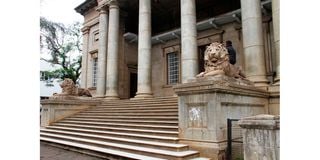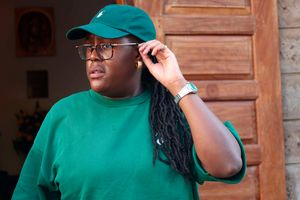Premium
The life and times of McMillan Library

The entrance to the McMillan Library.
What you need to know:
- It has a number of rollicking historical tales – and one of the tallest of them is about how the stone lions came to be at the library’s doors.
I first visited the McMillan Library in the late 1960s, when I was on secondment to teach at the University of Nairobi; the second time was in the early 1990s when I had returned to Kenya to set up a consultancy. My memory of both occasions is that the place was crammed with youngsters who had found a place where they could sit and study.
You must know it – the rather grandiose Palladian building in Banda Street. You enter it via 15 stone steps and the entrance is guarded by two impressive stone lions.
However, by the time of my second visit, though still a popular reading room, it was clear that the place was urgently in need of attention – needing not just a face-lift but a complete renovation.
Its full name is the McMillan Memorial Library. It was founded back in 1931 by Lady Lucy McMillan as a memorial for her husband.
By all accounts, Sir William Northrup McMillan was quite a character. He was a wealthy American who came to Kenya on a hunting trip. He enjoyed himself so much that he decided to stay on. He bought a 19,000-acre farm in Ol Donyo Sabuk.
He also had a splendid house in Chiromo. He was a big man and he had big appetites. He entertained lavishly and among the many famous guests he entertained were Winston Churchill and the American President, Teddy Roosevelt.
While reading up about the library, I came across the owaah.com website. It has a number of rollicking historical tales – and one of the tallest of them is about how the stone lions came to be at the library’s doors.
The story is that they were stolen from outside a mosque on Government Road (now Moi Avenue) by Teddy Roosevelt and his son on their way back to McMillan’s Chiromo house after a drunken night out at the Norfolk Hotel.
If you have seen those two lions you will know that story can’t be true. The two Roosevelts would have needed a pneumatic drill, a crane, a truck, and the help of a few workmen to carry those lions away. I’m afraid I would rather believe the account that is neatly chiselled on the stone plinths: that they were presented by McMillan’s cousin, Sir John Harrington.
Perhaps Lady McMillan had the library built in memory of her husband out of a twinge of guilt – guilt because of what happened at her husband’s funeral. The story is that it was his wish to be buried on the top of the Ol Donyo Sabuk mountain.
The day of the funeral it had rained all night. The vehicle carrying the coffin up the mountain kept getting stuck in the mud. Eventually, only about half way up, Lady McMillan said, ‘That’s far enough’. And that’s where her husband still lies.
I re-visited the library last Monday. It is still in a very sorry state. However, the needed help is on hand. I was able to talk with the library’s acting director, Jacob Ananda.
He confirmed the good news I had been reading about: that the Book Bunk Trust will be starting restoration work there early in the coming year. It is a huge task they will be taking on. But they have already completed restoration work on public libraries in Eastlands and Kaloleni.
I like their approach. They believe that public libraries should be more than repositories; they can be sites of knowledge production, shared experiences, cultural leadership and information exchange.
After its opening in 1931, for three decades, the library could be used only by Europeans. Its restoration will be carried out by a social impact firm founded by a couple of enterprising and visionary Kenyans: Wanjiru Koinangi and Angela Wachuka. I will be talking with them about their plans. And that will be next week’s story.
John Fox is Chairman of iDC Email: [email protected]





